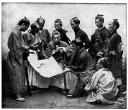
Needs analysis
This topic is divided into the following sections:
The e-mail submodule, "Easy business e-mail in English,"
which is the focus of this proposal, can be a stand-alone course for
Japanese businesspeople who need that training specifically.
Many of the points in this and the following sections overlap
those for other modules, but points specific to the e-mail submodule are identified as such.
A restatement of the MITI request
As we learned in the introduction, Japan's Ministry of International
Trade and Industry (MITI) has asked Bentley College to design and develop a
standardized training program in effective business English for Japanese
businesspeople all over Japan. To summarize the MITI request, the course should:
- Build on whatever English skills are already possessed by the learner.
- E-mail specific (and an expansion of what MITI had in mind
with the adjective effective):
Transfer to the learner sufficient skill with business English
so that the learner can write English e-mails that:
- Are correct in grammar, spelling, usage, and accepted style.
- Deliver the point efficiently, without misleading.
- Use the appropriate tone and do not offend.
(This is always a surprise to the Japanese, who deserve their
reputation as the most polite people in the world, that
their garbled English might be unintentionally offensive to Americans,
who deserve their reputation as the least polite people in the world.)
- Be "easy." This has two meanings:
- The course should not take up too much time.
MITI has stated that the typical learner has very little time for coursework.
- The course should overcome the learners' dread, distaste,
and hatred for English. Dr. Carliner has divined this very important "request,"
though MITI officials were too embarrassed to mention it.
- Be deployed (ready for delivery) in April 2002.
Back to the top
Performance and business issues driving the request for training
Japanese businesspeople currently have an atrocious, ludicrous level of
competence with business English.
To be specific, their English is typically burdened with
grammatical errors, garbled syntax, strange usage, illogical
or incomplete thought, and unintended connotation.
Yet, because English is essential in international commerce,
they must use it daily on the job.
It has long been evident that native English speakers are often misled
and are almost always amused by business correspondence from Japan.
Misleading English can and often does offend, generate expensive errors,
cause delays, and necessitate corrections and embarrassing apologies.
Amusing English means that the Japanese businessperson is not taken seriously.
The bottom line is not only loss of face, but also loss of business to Japan,
as overseas companies in delicate contract negotiations prefer
the more reliable communication with Hong Kong, Taiwan, the Philippines,
Korea, and India.
The loss is especially significant when a contract requires supporting
documentation in English.
Put simply, the Japanese businessperson needs far greater
fluency with business English, because the lack of this fluency is costing Japan money.
Back to the top
The skills to be addressed through training
The following are the skills to be addressed.
Each point describes a skill that learners should be able to do
and (unless otherwise indicated) they are not doing now at all
(or are doing it very poorly or only to a very small degree).
The entry skill level for learners in this course is a certified TOEIC score of 550.
E-mail specific:
Learners need to write intelligible e-mails.
Specifically, learners should be able to:
- [Some overlap with other modules]
Write with correct grammar, syntax, spelling, usage, and accepted style.
Use the following correctly:
- Articles
- Active and passive voice
- Tense, person, and mood
- Modifiers
- Emotion words
- Nominalizations
- Parallelism
- Phrasing (to break up noun strings)
- Deadwood-free prose
- Write the different parts of a note (opening, development, closing),
using commonly accepted usage conventions.
- Write e-mail notes that are comprehended the first time.
- Write with the appropriate tone, a tone that makes the desired impression
and does not offend.
- Write the type of e-mail appropriate for each business situation:

- Request or inquiry note
- Acknowledgment note
- Confirmation note
- Congratulations note
- Acceptance or approval note
- Rejection or refusal note
- Complaint note
- Disagreement note
- Apology note
- Introduction or recommendation note
- Invitation note
- Gratitude note
- Write a note that a recipient could not guess was written by a
non-native English speaker.
- Respond promptly to English e-mails received.
The Internet connects more than 60 million users in almost 100 different countries.
E-mail is the most widely used Internet capability.
A Japanese businessperson can send and receive letters and
files to and from millions of other people quickly, reliably, and inexpensively.
Most of the important e-mail is in English.
Unlike paper mail, e-mail is immediate, and typically does not afford the luxury
of staff help with English expertise.
The sender must write his or her own English,
usually within a 24-hour turnaround
(currently correspondence takes 3 to 5 business days to turn around,
probably due to the writer's insecurity with English).
- [Some overlap with other modules]
Distinguish good business writing from bad business writing
by identifying examples of each and explaining the qualities
that make the writing good or bad.
Back to the top
Who are the learners?
The learners are Japanese businesspeople, currently holding responsible
salaried positions in companies engaged in international commerce.
Their duties involve regular communication in English with customers,
vendors, and business partners in English-speaking countries.
All of them have attained a TOEIC score of 550.
Their experiences with learning English has generally been quite negative:
years in the public school memorizing the fine points of grammar
but with scant exposure to actual English in use, years in post-school
classes whose objectives (if there were objectives) were irrelevant to the business world.
The learners tend to be "workaholics."
They typically endure long daily train commutes,
and many of those who secure a seat on the jam-packed trains
occupy themselves with offline work on a laptop computer,
with reading, or with sleeping.
The reading material might be business materials
(reports and white papers from the office),
books about Japan's place in the world marketplace, or (especially with males,
but increasingly with females as well) the ever-popular adult comic books called
manga.
Once at the office, according to Pictorial Encyclopedia of Japanese Culture
(Tokyo: Gakken, 1987), "they hear a morning pep talk or perhaps loudly chant the
company's motto as a prelude to the day's work.
[They] often work overtime and without taking their allotted annual vacations...
Due to the lifetime employment system, [they have] a strong identification
with the company.
This in turn contributes to stability in management,
for the company and employee both feel as if they are in the same boat."
The work environment is a crowded "bullpen"; only managers have private offices,
and not all of them do.
Everywhere Japan is a noisy place, and the office is no exception.
There are abundant distractions from telephone conversations
and on-the-fly conferences in adjacent cubicles.
Everyone is aware of what everyone else is doing; privacy is an undreamed-of luxury.
 Older learners generally feel that work is what makes life worthwhile,
spending any limited free time relaxing in front of the TV
or playing a Japanese form of pinball called pachinko.
(Japanese executives prefer mah jong to pachinko.)
Older learners generally feel that work is what makes life worthwhile,
spending any limited free time relaxing in front of the TV
or playing a Japanese form of pinball called pachinko.
(Japanese executives prefer mah jong to pachinko.)
 Younger learners are more involved with their families
and spend free time in tennis, skiing, golf, jogging, or weekend carpentry.
All learners are computer-literate, and computer games are becoming more
popular--especially among the younger learners.
Younger learners are more involved with their families
and spend free time in tennis, skiing, golf, jogging, or weekend carpentry.
All learners are computer-literate, and computer games are becoming more
popular--especially among the younger learners.
The Japanese businessperson has very little time
and feels tremendous pressure to get work finished as nearly perfect as possible.
This learner typically does not view a training course
as a chance to get away from daily routines,
but as an annoying interruption to be avoided if at all possible.
The learner appreciates any training that has immediate on-the-job applications,
promises long-term career benefits, and enhances the company's prestige.
Compared with American students, Japanese learners are generally passive,
respectful, and quiet in classroom situations.
They often prefer to remain anonymous to other learners,
and they prefer to deal face to face with instructors as infrequently as possible.
(They tend to hold the instructor, or sensei, in some awe.)
Again compared with Americans, the Japanese are a homogenous society.
They readily conform to unspoken social norms, and they hate to stand out in the crowd.
Except for the differences between older and younger learners,
there are few "outliers" in this audience description.
Most of the learners can be categorized as "nibblers":
They would appreciate knowing just enough English to be able to write effective e-mails,
but few of them want to attain the fluency of a native English speaker.
They are tolerant of short grammar explanations, provided these explanations are
immediately applicable to improving the e-mails they need to write each day.
Though most learners have a deep-seated hatred of English,
they are nonetheless motivated to learn it,
since they know it will enhance their career by making them more valuable to their company.
Back to the top
The project constraints
This section is divided into the following subsections:
schedule, budget, staffing, and corporate culture of the sponsor.
Schedule
The entire comprehensive course must be ready for delivery throughout Japan on April 1, 2002,
the "drop-dead date."
Dr. Carliner is drafting the interim checkpoints (detailed instructional strategy points,
content outline for each module and submodule, subcontractor agreements, and testing).
Once this proposal is approved by MITI and the strategy points are clarified,
there will be a more granular schedule; for example,
interactive computer-based training involves detailed scripts,
flowcharts and storyboards, and programming and possibly animations.
Dr. Carliner is aiming on a 6-week contingency (a February 15 actual completion date).
Budget
Of course, the overall budget should not exceed the quoted bid of 1.5 billion yen.
Dr. Carliner, who has quite a bit of experience with such estimates,
has incorporated at least a 15% contingency into that quote,
with the presumption that Bentley might be developing computer-based training
(provided this needs analysis and the objectives point to CBT as an appropriate
instructional strategy), and CBT is far more expensive than classroom training to develop.
Budgetary considerations are expanded in the
Instructional
strategy topic,
but given MITI's acceptance of the fat quote and the full year development time,
we can assign the following priorities:
(1) quality, (2) schedule, and (3) budget--in that order.
What a luxury to be empowered to develop the best program we can think of!
Staffing
Staffing will certainly include an instructional designer
(for the entire comprehensive course and for each module),
a course developer for each module, a project manager for the entire course,
an editor for the entire course (and perhaps editors for some of the individual modules),
an art director for the entire course and graphic designers for each module,
and production people both for the entire course and for individual modules.

Corporate culture of the sponsor
The corporate culture of the Japanese businessperson has been
described already.
This section will describe some of the characteristics of the sponsor, MITI.
MITI officials, in common with most Japanese, have a very deep respect for learning,
and they regard an instructor (sensei) with something close to reverence.
On the other hand, though the officials at MITI have obviously recognized the need
for training in English, they themselves speak very little English
and have very little interest in learning it.
In the negotiations with the sponsor, Bentley representatives
will need to be sensitive to this and work very hard to communicate effectively.
 MITI is willing to supply an interpreter for each conference,
but it is important to bring up that need in preparing for each conference.
Be alert to the possibility that the interpreter might not be skilled
in the nuances of rapidly spoken English.
For delicate negotiations, Bentley should consider hiring its own interpreter,
who (taking account of the sensitivities of the MITI interpreter) stays in the background,
stepping in only when a looming misunderstanding is apparent.
MITI is willing to supply an interpreter for each conference,
but it is important to bring up that need in preparing for each conference.
Be alert to the possibility that the interpreter might not be skilled
in the nuances of rapidly spoken English.
For delicate negotiations, Bentley should consider hiring its own interpreter,
who (taking account of the sensitivities of the MITI interpreter) stays in the background,
stepping in only when a looming misunderstanding is apparent.
For both interpreters, avoid using American idioms and buzzwords,
such as "throwing a monkey wrench into the plans," "cut to the chase,"
"till the cows come home," "to talk turkey," "catch as catch can," and "It's a wrap."
Also avoid technical terms except where they are absolutely necessary.
Finally, be very careful of humor; very little American jocularity translates
well into Japanese.
Back to the top
Go to the next topic, "Goals"
Notes
- In Japan, manga is serious business.
According to Basic Japanese through Comics (Atlanta: Mangajin, 1993),
manga, unlike American-style comics, is "not just 'kid stuff' but a highly
developed medium for entertainment and education, very popular among adults."
Manga is estimated to account for over a third of all books and magazines
published in Japan.
Because it is so widely read, manga is "as powerful as TV in
shaping popular culture, and [it] plays an important role in forming
national attitudes, starting national fads, and shaping the national language in Japan.
A growing number of government agencies, and some of the biggest names in corporate Japan,
are now even using manga in training materials, product manuals,
and corporate histories."
Return to your place.
Back to the top

